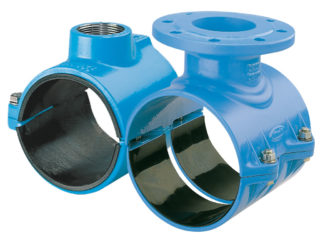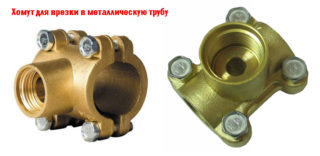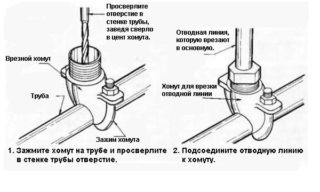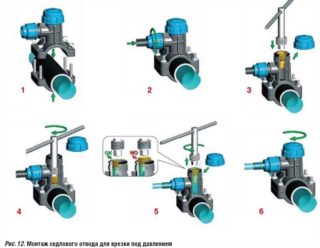To make an extension to connect an additional unit of sanitary equipment or to form a new circuit, you will need a clamp for tapping into the water supply network. In order for the connection to be strong, it is important to choose the right shaped element and correctly install it.
Scope of the part
A tie-in will be required in such cases:
- connecting a new water intake point, for example, a washing machine or dishwasher;
- acquisition and launch of new water consumers, for example, a jacuzzi;
- replacement of water supply pipes, if they have become unusable or for the purpose of carrying out work on the modernization of the water supply system.
These details will be required when redeveloping housing with a new location of sinks, baths, moving faucets, creating combined or separate bathrooms - bathrooms and toilets.
A tie-in into public water supply pipelines of the main type also occurs with the use of clamps. But these actions cannot be performed without the appropriate permission. The implementation of an unauthorized tie-in entails bringing the owner to material and administrative responsibility.
Connection to a large-diameter main-type public water supply system, bypassing metering devices, is strictly prohibited.
Types of clamps and selection features

The yoke is used to connect a non-pressurized water supply main line to the pipeline. The device consists of two parts, one of which is equipped with an outlet with an internal thread. The installation of the cage coupling for tapping into the water supply is carried out by means of a bolted connection. Such an accessory is made of HDPE or metal.
The drilling clamp for tapping into the water supply system under pressure is a prefabricated module equipped with special nozzles and swivel connectors. It is mounted on polymer, cast iron and steel water supply lines.
The electrowelded water pipe saddle is used exclusively for tapping into plastic systems. The device contains a cutter for drilling holes in pipes made of polymer, installed in a shut-off element with a branch, and a heating coil.
Simple saddle clamps are used for tapping into asbestos-cement, polymer and metal lines. The device differs from the clamp-clip in that it structurally consists of the main part - the “saddle”, which is fixed to the pipe using an elastic clamping bracket. The tightness of the connecting element to the water pipe is ensured by special rubber seals, which guarantee the tightness of such a connection. Most of these devices are made of metal.
Saddle clamps are universal. They can be used to connect to the main pipeline, both under pressure and without it.
Tie-in methods
Clamp installation on plastic pipes
In the in-house network, you can stop the flow of fluid, if necessary, simply by turning off the main tap. Therefore, in order to perform a tie-in in this case, only a conventional tee is required. The technological process itself is carried out in this way:
- The main shut-off element is shut off, and after that - the tap located at the very bottom of the system for draining the liquid from the water supply.
- The line is divided at the required section by means of an angle grinder or a pipe cutter by cutting out a section equal in length to the inserted fitting. Before performing such an operation, it will be necessary to install a suitable container under the place of the future cut to collect the water remaining in the pipeline.
- A tee is cut into a plastic water pipe in the same way as a standard coupling, the joints are welded using a special soldering iron for propylene pipes.
- A shut-off valve is installed in the branch of the tee, which makes it possible to shut off the new water line. After that, the water supply system can be used, you just need to open the main shut-off element.
The installation of a new branch can be carried out while the pipeline is under pressure, since a separate shut-off valve is installed on the branch of the tee.
The best option for polymer pipes is a collapsible clamp with a built-in heating coil. During installation, it is disassembled, installed in the place of the tie-in and soldered to the pipe by means of a welding machine. Thanks to this method of connection, a sealed and high-strength connection is obtained.
Work on a metal plumbing
- Attach the clamp to the pipe surface.
- A hole is drilled.
- Install the plug in the form of a dedicated screw.
The use of a clamp with a valve is also available. Here the order is the same: a hole is made, the drill is removed and the valve is closed.
On external water supply networks, earthmoving work will be required. You will need to dig a pit measuring 150 x 150 centimeters and 50 cm deep below the main line. You can start excavation using an excavator until a tape of metal or polymer appears, which is laid over the highway at a height of 30-50 cm. Further work is carried out exclusively with shovels. If a well is already mounted at the tie-in point, these steps will not be required.
The final phase is the diversion of the water supply branch from the main pipe. The new plumbing line starts at the saddle shut-off valve and ends at the water meter.
Features of tapping into a cast iron pipeline
To drill the hole, you need a carbide bit. In the process of work, it quickly breaks down, it is better to have three or four spare parts at hand.
When working with cast iron, the following nuances must be taken into account:
- The fragility of the material. The pressure on it should be kept to a minimum.
- Obligatory removal of the anti-corrosion coating. It is applied to all pipes.
- Inadmissibility of overheating of the crown.
Drilling must be carried out with the lowest speed of the working tool.
With a competent approach to the selection of a clamp and its correct use, you can carry out an independent installation of a water supply system using a simple and affordable tool.











